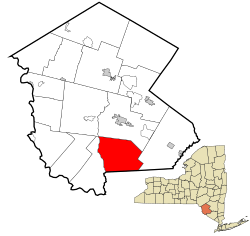Forestburgh, New York
| Forestburgh, New York | |
|---|---|
| Town | |
 Location of Forestburgh in Sullivan County, New York |
|
| Coordinates: 41°33′44″N 74°42′45″W / 41.56222°N 74.71250°WCoordinates: 41°33′44″N 74°42′45″W / 41.56222°N 74.71250°W | |
| Country | United States |
| State | New York |
| County | Sullivan |
| Area | |
| • Total | 56.8 sq mi (147.1 km2) |
| • Land | 55.2 sq mi (143.0 km2) |
| • Water | 1.6 sq mi (4.2 km2) |
| Elevation | 1,417 ft (432 m) |
| Population (2010) | |
| • Total | 819 |
| • Density | 14/sq mi (5.6/km2) |
| Time zone | Eastern (EST) (UTC-5) |
| • Summer (DST) | EDT (UTC-4) |
| ZIP code | 12777 |
| Area code(s) | 845 |
| FIPS code | 36-26528 |
| GNIS feature ID | 0978963 |
| Website | www |
Forestburgh is a town in Sullivan County, New York, United States. The population was 819 at the 2010 census. It is where the Neversink River enters the Neversink Gorge and flows over High Falls. The ZIP code of Forestburgh, New York is 12777.
The Town of Forestburgh is in the south-central part of the county.
The town was formed from parts of the Towns of Mamakating and Thompson in 1837.
Forestburgh's main industries in its early years were tanning, quarrying and lumbering. The mountains on either side of Bushkill Creek contained quarries of flagging, curbing and building stone (also known as bluestone). The largest of these was Paradise Quarry in Oakland Valley. Stone from this quarry was used to construct the Episcopal Church in Monticello. Many of the old sidewalks in New York City were said to have come from this area. The largest tannery was at Gilman's Station, which was later renamed St. Joseph's Station. According to French's Gazette, published in 1858, there were thirty-nine tanneries within the township, producing 100,000 sides of leather annually.
The opening of the Monticello and Port Jervis Railroad in the 1870s stimulated the lumbering, tanning and quarrying industries. The railroad entered Forestburgh at the Town's northern border and extended through it in a southernly direction along the Bushkill Creek Valley. In addition to assisting the Town's industrial base, the railroad also brought summer residents from New York City. The population of the Town in 1870 was 916, greater than the present day population of 833.
The quarrying industry began to decline in the late 1890s with the invention of concrete. The oak and hemlock bark used in tanning became scarce, signaling the end of the tanning industry. It was at this point, however, that the resort industry began to flourish in Forestburgh. Many homes in Oakland Valley began operating as boarding houses during the summer months when city residents came north on the train from New York. The Hartwood Club and Merriewold Park were born, and the Convent of St. Joseph's was established, along with summer camps for boys and girls and a Catholic boarding school.
By the mid-twentieth century the automobile caused the railroad to cease operation in Forestburgh. This substantially reduced the number of tourists who came to the town by train. Forestburgh slowly evolved into a rural-residential town, with many people commuting to jobs in nearby towns.
...
Wikipedia
